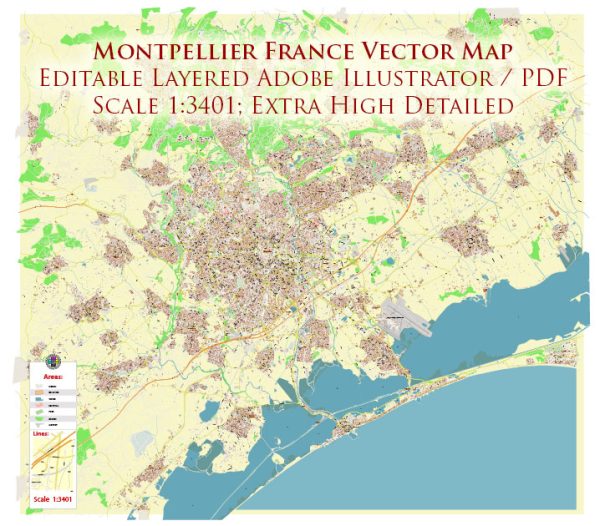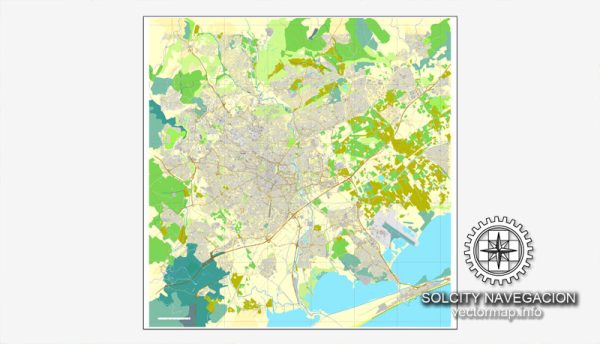Montpellier, France, is a vibrant city in the Occitanie region known for its rich history, beautiful architecture, and dynamic cultural scene.
Vectormap.Net provide you with the most accurate and up-to-date vector maps in Adobe Illustrator, PDF and other formats, designed for editing and printing. Please read the vector map descriptions carefully.
Here’s an overview of its principal streets, roads, and key attractions:
Principal Streets and Roads
- Avenue du Général de Gaulle:
- Description: A major avenue in Montpellier that connects the city center with the western suburbs. It is lined with shops, cafes, and important buildings, serving as a key thoroughfare for both traffic and pedestrians.
- Rue de la Loge:
- Description: A prominent street in Montpellier’s historic center, Rue de la Loge is known for its charming shops, cafes, and historic buildings. It runs parallel to the Place de la Comédie, the city’s central square.
- Rue Foch:
- Description: Located near the Place de la Comédie, Rue Foch is a bustling street with a variety of shops, restaurants, and cafes. It’s a key route for accessing the city’s main attractions and cultural sites.
- Rue Jean Moulin:
- Description: This street runs through the city center and features a mix of residential and commercial properties. It is known for its proximity to several key landmarks and attractions.
- Boulevard du Jeu de Paume:
- Description: A major boulevard that circles the historic center of Montpellier, offering access to various neighborhoods and serving as an important route for both local and through traffic.
City Attractions
- Place de la Comédie:
- Description: The central square of Montpellier, also known as “L’Œuf” (the Egg) due to its shape. It is surrounded by historic buildings, cafes, and the Opéra Comédie. The square is a focal point for city life and cultural events.
- Opéra Comédie:
- Description: A grand opera house located on the Place de la Comédie. Known for its beautiful architecture and cultural performances, it is one of Montpellier’s most iconic buildings.
- Montpellier Cathedral (Cathédrale Saint-Pierre):
- Description: A historic Gothic cathedral located near the city center. It features impressive architecture, including a large facade and beautiful interior details.
- Musée Fabre:
- Description: An art museum located on the Place de la Comédie, housing a significant collection of European art from the Renaissance to contemporary works. The museum is renowned for its impressive galleries and exhibitions.
- Promenade du Peyrou:
- Description: A grand promenade featuring a large open space with gardens, fountains, and the iconic Saint-Clément Aqueduct. It offers stunning views of the city and is a popular spot for walking and relaxation.
- Jardin des Plantes:
- Description: The oldest botanical garden in France, located near the city center. It features a diverse collection of plants, trees, and beautifully landscaped gardens.
- Aqueduc Saint-Clément:
- Description: An impressive historical aqueduct built in the 18th century that once supplied water to Montpellier. It is now a prominent landmark and part of the Promenade du Peyrou.
- Palais des Congrès Le Corum:
- Description: A modern conference center and performance venue designed by architect Claude Vasconi. It hosts various events, including concerts, conferences, and exhibitions.
- Château de Flaugergues:
- Description: A historic château located on the outskirts of Montpellier, known for its beautiful gardens, vineyards, and architecture. It offers guided tours and hosts events throughout the year.
- Place Saint-Roch:
- Description: A charming square in the heart of Montpellier’s historic district, surrounded by cafes and shops. It features a fountain and is a popular spot for socializing and relaxation.
Montpellier’s blend of historical landmarks, cultural institutions, and vibrant street life makes it a dynamic destination for visitors. The city’s well-preserved architecture and lively atmosphere reflect its rich heritage and contemporary vitality.



 Author: Kirill Shrayber, Ph.D.
Author: Kirill Shrayber, Ph.D.